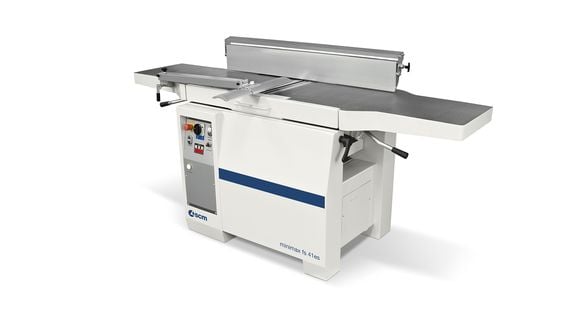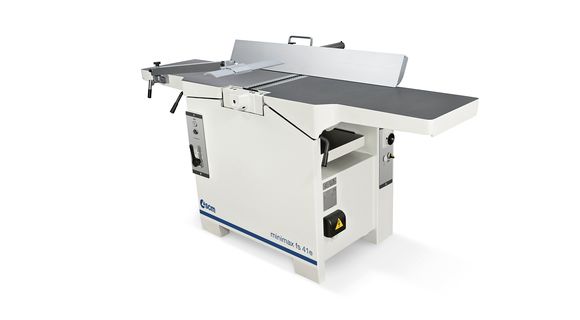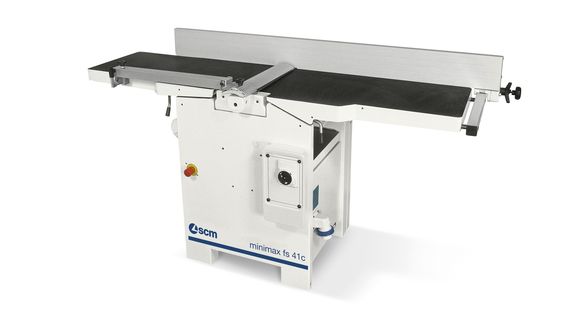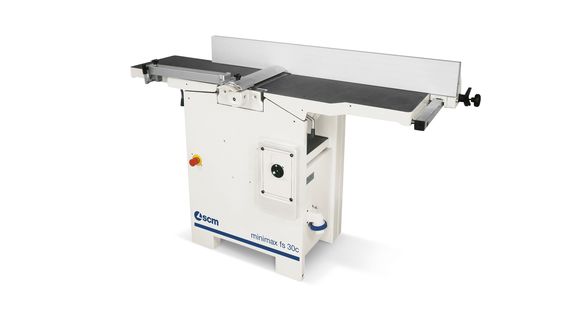Combined planer-thicknesser
The SCM joinery machines are the products of continuing in-house development complementing the sum of the finest skills and know-how.
The planer thicknesser is a combined woodworking machine that brings together surface planer and thicknessing planer machining operations.
Scm's combined planer-thicknessers allow you to switch from one process to another in a short period of time.
This rapid switching from surface planer to thicknessing planer is essential to the work of joiners or DIY enthusiasts who find themselves working on a single piece; so, unlike mass production where you would pass through a number of pieces on one of the planers before changing to another, in this case, one single piece is processed on both planers and the switching speed from one planer to another makes their work easier and faster.
Scm's combined planer-thicknessers are compact and sturdy and suited to highly flexible production. Ideal for demanding craftsmen and joiners.
Read moreDon’t I give up some advantages by going with a combined jointer/planer over separate machines?
It depends on your situation and space. For a one or two man shop in a small space the combo is the only way to go, in my opinion, and I would argue that it is not really a close or fair comparison. The standard for most small shops I have been in over the last 40 odd years is a 6” jointer (maybe 8” if they can fit it) and a 12” lunchbox planer (or maybe a 15” stand alone). And those need to be on wheels and/or stored when not in use. How many times to you get boards wider than 6-8”? Pretty often. Wider than 12”? Not so much, at least not with common stock. With a 12” or 16” jointer/planer combo there would be far fewer workarounds needed, greater capacity in most cases, more horsepower, better quality – and it will take up half the space. All for less money (if comparing equal sizes), or just a bit more money if comparing to the “Standard” we discussed above.
Read moreWhy do European jointer/planer combos generally have shorter jointer beds than stand-alone jointers of the same width?
These are designed as space savers first, so a longer bed makes less sense. When you consider that most small shops focus on furniture parts there really isn’t much call to straighten and edge or flatten a face more than 72” or shorter. Unless you’re making molding you don’t have much need for longer boards, and there is no point in jointing an edge or face with molding. Just thickness it and shape the profile. It just doesn’t need that precision, and it is incredibly wasteful, often resulting in 3-4’ of unusable stock from a 10’ board. For those times when you do need to work with 8’ or greater lengths, like for a dining table top, then you can get extension systems from several aftermarket vendors, or make your own. These combination machines tend to focus on width more than length, and you will find that much more practical, useful and beautiful with the greater design possibilities that wider stock offers.
Read moreIsn’t the changeover a real hassle?
One minute per change. The average furniture projects requires, maybe, 1 hour of total milling time between the jointer and planer functions, and 1-3 changeovers, at most, during that hour. Now compare that to separate machines, with lesser capacities, and both machines on wheels and/or stored away. To go from jointer to planer requires you to move one machine out of the way and move the other one in. Switch over the dust collection hose, electrical connection. Now you are talking 3-5 minute per changeover, and more hassle. I have experienced both worlds, and it is not even close – the combination machine is quicker by far.
Read moreDo you have to adjust your jointer every time you go from planer back to jointer?
Not with Minimax. Everything is registered and machined to precision. Once set you can reliably return to the same exact setting time and time again, with no need to re-adjust anything.
Read moreWhat is the right cutter head for me, the Xylent helical head or the straight knife Tersa System?
It is kind of a “Great taste!... Less Filling!” debate. Both Tersa and Xylent are great systems. If you are more of an artisan shop Tersa probably has the edge and if you are more of a production shop the advantage probably falls to Xylent. Contrary to popular beliefs and internet buzz and chatter, tests show time and again that the best finish is still achieved with a freshly sharpened straight knife, like Tersa. However, you can go longer times between knife changes with the carbide knives found on the segmented, helical heads. Both systems are intelligent and elegant solutions that require no knife setting. You can change knives with Tersa in under 2 minutes, and depending on the size of the planer and your head’s diameter it could take 7-10 minutes to turn all the knives on a Xylent head. Both systems are quieter than a standard head, Tersa because its knives are only 2mm proud of the cutter head body, however if a quiet system is very important to you then the Xylent head makes the least sound.
Read moreWhy are there grooves in the cast iron work tables instead of them being ground smooth?
The milling process on the table does have an advantage over smooth surfaces and is more expensive to do. It is also more efficient. This can be extremely advantageous on a jointer or planer table. As a board’s face gets flatter it gains more surface area resistance and creates more vacuum between the face and the table. Thus, it gets harder to push. The grooves make it harder for the vacuum effect to take hold. It’s subtle, but you will notice a difference.
Read moreWhat advantages do the Minimax Jointer/Planers provide over the competition?
There are several. In terms of use, the Minimax jointer/planers have the best, quickest changeover times, mainly due to the fact that with Minimax the planer table does not have to be all the way down when using the jointer. That can add up to 25 fewer turns of the position wheel, each way, every time you switch between jointer and planer. With other manufacturers the dust port ends up on opposite sides of the machine, but not with Minimax -- our dust port ends up in the same exact position on each function so you don’t need to have a longer hose, and have to move it or reposition your dust collection. In general, you will also find heavier components on the Minimax machines, thicker castings, better milling. And due to tighter tolerances the Minimax machines will hold their settings over a longer period of time. The Minimax fence is longer, taller and more rigid, and can be locked at two points for zero flex vs. the cantilevered design of others. You have more and varied cutter head options, too. The basic Minimax design goes back 40 years or more with machines from all eras still going strong in shops around the world.
Read more


